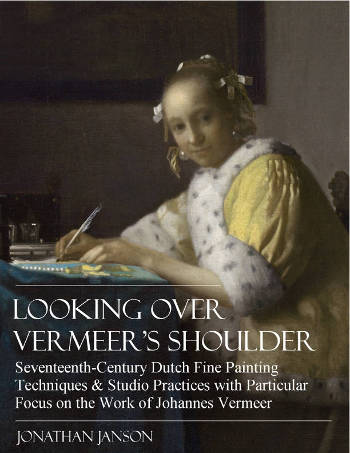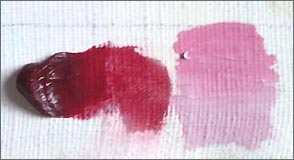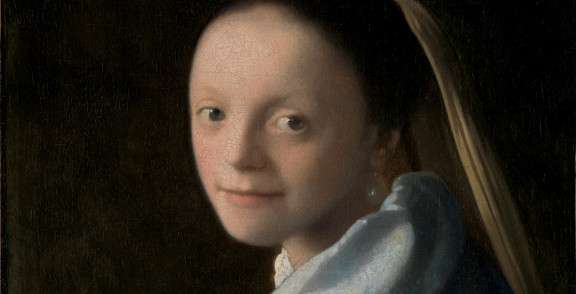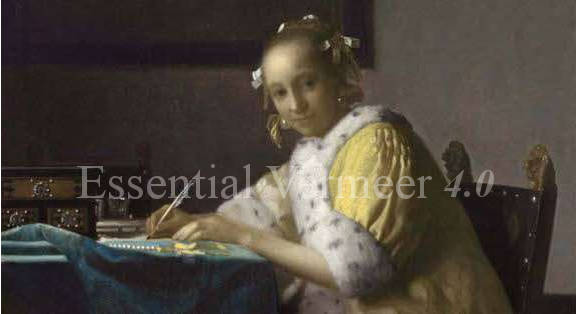Origin, History and Characteristics
(cochineal, crimson lake)
Carmine is a natural organic dyestuff made from the dried bodies of the female cochineal insect, Dactylopius coccus, which lives on various cactus plants in Mexico and in Central and South America (fig. 1). Carmine must be precipitated on clay, since it has no body of its own. It was brought to Europe shortly after the discovery of the New World, first described by Pietro Andrea Mattioli in 1549.
After the Spanish conquest of the Aztec Empire (1519-21), which established trade routes with the New World., cochineal was exported to Spain. From there, it was regularly sent to Antwerp. In the seventeenth century, cochineal was so valuable that its price was often quoted on the Amsterdam commodity exchange.
"The color could be extracted from pieces of cloth that had already been dyed. The finest quality, known as nacarat carmine, is non poisonous and quite beautiful with the peculiarity of being more permanent in transmitted light as a transparent color, than when under direct light."Abbie Vandivere, "11. Seeing red," Girl with a Blog, Mauritshuis, accessed Augut 13, 2023.
The process of turning cochineal into a paint involves several steps. First, the red dye is extracted from the dried and crushed insects. This dye is then purified and often turned into a lake pigment by precipitating it onto a substrate, usually hydrated alumina. The pigment is finely ground and mixed with a binder such as oil, gum arabic, or acrylic to create the final paint.
Historically, carmine has been a prized pigment due to its vividness and intensity. It was often used for glazing and was mixed with other pigments to create a range of reds and purples. Given its cost, it was typically reserved for important commissions or for specific, focal areas of a painting, such as garments in portraiture.
 fig. 1
fig. 1 Indian Collecting Cochineal with a Deer Tail’ from Memoria sobre la naturaleza, cultivo, y beneficio de la grana (...), 1777, by José Antonia de Alzate y Ramirez, Source: Newberry Library: Vault Ayer MS 1031.
When it comes to its brushing characteristics, carmine is generally smooth and flows well, especially in oil and watercolor mediums. It is an intensely vivid pigment, so a small amount can have a significant impact. The pigment is often semi-transparent, making it particularly useful for glazing techniques that create depth and luminosity in a painting.
As for drying, carmine dries at a moderate rate in oil form—not as quickly as some earth pigments but faster than some of the modern synthetic ones. The finish can vary depending on the medium used, but in oils, it often has a slight sheen, adding to its vibrancy.
According to Maximilian Toch, it is only legitimate for use as a food coloring, as exposure to the sunlight for three months, bleaches the pigment completely.
As a note, carmine dye was a popular choice for fabric coloring in the Americas and emerged as a significant export during the 16th-century colonial era. However, with the invention of synthetic pigments and dyes like alizarin in the late nineteenth century, the reliance on natural dyes began to wane. Concerns about the safety of synthetic food additives in recent times have revived the demand for cochineal dyes. As a result, cultivating the insect has become economically viable again. Currently, Peru is the leading producer, with Mexico, Chile, Argentina, and the Canary Islands trailing behind.
For the Old Masters, preserving the integrity of their colors was a matter of great importance. Commonly used pigments, such as brown and yellow earth tones, were typically prepared in bulk. These were stored in small earthenware pots, sealed with parchment and tightly tied to prevent them from drying out. On the other hand, more valuable pigments like ultramarine and carmine were prepared in limited quantities. These were stored in pig bladders that were specially sealed to be airtight. When these high-value colors were needed, a small hole was punctured in the bladder with a short nail, allowing the paint to be squeezed out much like it is from a modern tube. After use, the small hole was resealed with the same nail to maintain the paint's freshness. For pigments that were seldom used, small shells served as convenient storage containers.
Carmine in Vermeer's Painting
Carmine has been detected in only three of Vermeer's paintings, The Love Letter, The Procuress and Girl with a Pearl Earring. In The Love Letter (fig. 2) it was most likely used in the design of the leather guilt wall covering behind the two sitters or in the hanging curtain. In cross-sections taken from the Girl with a Pearl Earring, "red lake is sometimes visible as particles that appear deep red in normal light, and fluoresce bright pink in UV. Because red lake fades over time, it is harder to see some of the particles. But when paint fragments from the Girl’s skin and clothing were examined with the chromatographic technique UHPLC, the were found to contain carmine, most likely made from Mexican cochineal. The distribution of red lakes in her lips and skin using ultraviolet fluorescence infrared examination."Abbie Vandivere, "11. Seeing red," Girl with a Blog, Mauritshuis, accessed [Augut 13, 2023], https://www.mauritshuis.nl/en/our-collection/restoration-and-research/closer-to-vermeer-and-the-girl/girl-with-a-blog/red-pigments-girl-with-a-pearl-earring-vermeer/. Vermeer most likely used carmine more extensively but either in areas which have not been examined or else it has suffered fading.
Carmine Resourses
- Kirby, Jo, Marika Spring, and Catherine Higgitt. 2005. "The Technology of Red Lake Pigment Manufacture: Study of the Dyestuff Substrate." National Gallery Technical Bulletin 26:71–87.
- Hermann Kühn, "A study of the pigments and the grounds used by Jan Vermeer," Technical Reports: Report anda Studies in the History Art 2 (1968): 176–202..
- Kirby, Jo, and Raymond White. 1996. "The Identification of Red Lake Pigment Dyestuffs and a Discussion of their Use." National Gallery Technical Bulletin 17:56–80.
- Kirby, Jo, Susie Nash, and Joanna Cannon, eds. 2010. Trade in Artists’ Materials: Markets and Commerce in Europe to 1700. London: Archetype.
- Gettens, Rutherford J., and George L. Stout. 1966. Painting Materials: A Short Encyclopedia. Courier Dover Publications. Google Books.
- Wikipedia. s.v. “Cochineal.”
LOOKING OVER VERMEER'S SHOULDER
The complete book about Johannes Vermeer's and 17th-century fine-painting techniques and materials
by Jonathan Janson | 2020

Enhanced by the author's dual expertise as both a seasoned painter and a renowned authority on Vermeer, Looking Over Vermeer's Shoulder offers an in-depth exploration of the artistic techniques and practices that elevated Vermeer to legendary status in the art world. The book meticulously delves into every aspect of 17th-century painting, from the initial canvas preparation to the details of underdrawing, underpainting, finishing touches, and glazing, as well as nuances in palette, brushwork, pigments, and compositional strategy. All of these facets are articulated in an accessible and lucid manner.
Furthermore, the book examines Vermeer's unique approach to various artistic elements and studio practices. These include his innovative use of the camera obscura, the intricacies of his studio setup, and his representation of his favorite motifs subjects, such as wall maps, floor tiles, and "pictures within pictures."
By observing closely the studio practices of Vermeer and his preeminent contemporaries, the reader will acquire a concrete understanding of 17th-century painting methods and materials and gain a fresh view of Vermeer's 35 masterworks, which reveal a seamless unity of craft and poetry.
 While the book is not structured as a step-by-step instructional guide, it serves as an invaluable resource for realist painters seeking to enhance their own craft. The technical insights offered are highly adaptable, offering a wealth of knowledge that can be applied to a broad range of figurative painting styles.
While the book is not structured as a step-by-step instructional guide, it serves as an invaluable resource for realist painters seeking to enhance their own craft. The technical insights offered are highly adaptable, offering a wealth of knowledge that can be applied to a broad range of figurative painting styles.

LOOKING OVER VERMEER'S SHOULDER
author: Jonathan Janson
date: 2020 (second edition)
pages: 294
illustrations: 200-plus illustrations and diagrams
formats: PDF
$29.95
CONTENTS
- Vermeer's Training, Technical Background & Ambitions
- An Overview of Vermeer’s Technical & Stylistic Evolution
- Fame, Originality & Subject Matte
- Reality or Illusion: Did Vermeer’s Interiors ever Exist?
- Color
- Composition
- Mimesi & Illusionism
- Perspective
- Camera Obscura Vision
- Light & Modeling
- Studio
- Four Essential Motifs in Vermeer’s Oeuvre
- Drapery
- Painting Flesh
- Canvas
- Grounding
- “Inventing,” or Underdrawing
- “Dead-Coloring,” or Underpainting
- “Working-up,” or Finishing
- Glazing
- Mediums, Binders & Varnishes
- Paint Application & Consistency
- Pigments, Paints & Palettes
- Brushes & Brushwork
- BOON, J. and OBERTHALER, E., "Mechanical Weakness and Chemical Reactivity Observed in the Paint Structure and Surface of 'The Art of Painting'" in Vermeer: Die Malkunst - Spurensicherung an einem Meisterwerk, exh. cat., Kunsthistorisches Museum, Vienna 2010, 235–53 and 328–35.
- CARYLE, Leslie A. "Beyond a Collection of Data: What We Can Learn from Documentary Sources on Artists' Materials and Techniques." In Historical Painting Techniques, Materials, and Studio Practice: Preprints of a Symposium, edited by Arie Wallert, Erma Hermens, and Marja Peek, 1-5. University of Leiden, the Netherlands, 26-29 June 1995.
- COSTARAS, Nicola. "A Study of the Materials and Techniques of Johannes Vermeer." In Vermeer Studies, edited by Ivan Gaskell and Michiel Jonker, Studies in the History of Art 55, Center for Advanced Study in the Visual Arts, Symposium Papers XXXIII. Washington: National Gallery of Art & New Haven: Yale University Press, 1998, 145–167.
- DELANEY, John K., Kathryn A. Dooley, Annelies van Loon, and Abbie Vandivere. “Mapping the Pigment Distribution of Vermeer’s Girl with a Pearl Earring.” Heritage Science 8, no. 4 (January 7, 2020). Accessed May 2, 2022.
- EASTAUGH, Nicholas, Valentine Walsh, Tracey Chaplin and Ruth Siddall. The Pigment Compendium 2017. Rev. ed. (e-version). London: The Pigmentum Project, 2016.
- FINK, Daniel A. "Vermeer's Use of the Camera Obscura: A Comparative Study." The Art Bulletin 53 (1971).
- GIEBE, Marlies. “Johannes Vermeers ‘Kupplerin’: Restaurierung Und Maltechnische Befunde.” In Uta Neidhardt and Marlies Giebe, eds., Johannes Vermeer: Bei der Kupplerin, 39–64. Exh. cat. Dresden: Michel Sandstein in association with Gemäldegalerie Alte Meister, Staatliche Kunstsammlungen, 2004.
- GIFFORD, E. Melanie, Anikó Bezur, Andrea Guidi di Bagno, and Lisha Deming Glinsman. “The Making of a Luxury Image: Van Aelst’s Painting Materials and Artistic Techniques.” In Tanya Paul, James Clifton, Arthur K. Wheelock Jr., and Julie Hochstrasser, Elegance and Refinement: The Still-Life Paintings of Willem van Aelst, 80–84. Exh. cat. New York: Skira Rizzoli, 2012.
- GIFFORD, M. "Painting Light: Recent Observations on Vermeer's Technique." In Vermeer Studies, edited by Ivan Gaskell and Michiel Jonker. Washington, D.C.: National Gallery of Art & New Haven and London: Yale University Press, 1998, 185–199.
- GIFFORD, E. Melanie, and Lisha Deming Glinsman. “Collective Style and Personal Manner: Materials and Techniques of High-Life 'Genre Painting'.” In Waiboer, Wheelock, and Ducos, Vermeer and the Masters of Genre Painting, 65–84, 270–74.
- GIFFORD, E. Melanie, Dina Anchin, Alexandra Libby, Marjorie E. Wieseman, Kathryn A. Dooley, Lisha Deming Glinsman, John K. Delaney. "First Steps in Vermeer’s Creative Process: New Findings from the National Gallery of Art," Journal of Historians of Netherlandish Art 14, no. 2 (Summer 2022).
- GIFFORD, E. Melanie. “Fine Painting and Eloquent Imprecision: Gabriel Metsu’s Painting Technique.” In Adriaan E. Waiboe, Gabriel Metsu, 154–79. New Haven: Yale University Press in association with the National Gallery of Art, 2010.
- GIFFORD, E. Melanie. “Lievens’ Technique: ‘Wonders in Smeared Paint, Varnishes and Oils.’” In Jan Lievens: A Dutch Master Rediscovered, edited by Arthur K. Wheelock Jr., 41–53. Exh. cat. New Haven: Yale University Press in association with the National Gallery of Art, 2008.
- GIFFORD, E. Melanie. “Material as Metaphor: Non-Conscious Thinking in Seventeenth Century Painting Practice.” In Studying Old Master Paintings: Technology and Practice, edited by Marika Spring, 165–72. London: Archetype in association with The National Gallery, 2011.
- GIFFORD, E. Melanie. “Painting Light: Recent Observations on Vermeer’s Technique.” In Vermeer Studies, edited by Gaskell and Jonker, 185–99.
- GROEN, Karin M., Inez D. van der Werf, Klaas Jan van den Berg, and Jaap J. Boon. "Scientific Examination of Vermeer's 'Girl with a Pearl Earring'." In Vermeer Studies, edited by Ivan Gaskell and Michiel Jonker. Washington, D.C.: National Gallery of Art & New Haven and London: Yale University Press, 1998, 169–183.
- HOMMES, M.H. van Eikema. "Verdigris Glazes in Historical Oil Paintings: Instructions and Techniques." In Discoloration in Renaissance and Baroque Oil Paintings. Instructions for Painters, Theoretical Concepts, and Scientific Data. Dissertation, 2002.
- HOWARD, Helen, David Peggie and Rachel Billinge. "Vermeer and Technique." National Gallery website. https://www.nationalgallery.org.uk/research/about-research/the-meaning-of-making/vermeer-and-technique
- JANSON, Jonathan. Looking Over Vermeer's Shoulder: Seventeenth-Century Painting Techniques and Studio Practices with Particular Focus on the Work of Johannes Vermeer, second edition. USA, 2020.
- KÜHN, Herman. "A Study of the Pigments and the Grounds used by Jan Vermeer." Reports and Studies in the History of Art. Washington: National Gallery of Art, 1968.
- LAURENZE-LANDSBERG, Claudia. “Neutron-Autoradiography of Two Paintings by Jan Vermeer in the Gemäldegalerie Berlin.” In Wolfgang Lefèvre, ed., Inside the Camera Obscura: Optics and Art under the Spell of the Projected Image, 213–25. Berlin: Max-Planck Institute for the History of Science, 2007.
- LEVY-HALM, Koos. “Where Did Vermeer Buy His Painting Materials? Theory and Practice.” In Gaskell and Jonker, Vermeer Studies, 137–43.
- LIBBY, Alexandra, E. Melanie Gifford, Dina Anchin, Marjorie E. Wieseman, Kathryn A. Dooley, Lisha Deming Glinsman, John K. Delaney. "Experimentation and Innovation in Vermeer’s Girl with the Red Hat: New Findings from the National Gallery of Art," Journal of Historians of Netherlandish Art 14, no. 2 (Summer 2022).
- LIEDTKE, Walter A., Richard C. Johnson, and Don H. Johnson. “Canvas Matches in Vermeer: A Case Study in the Computer Analysis of Fabric Supports.” Metropolitan Museum Journal 47 (2012): 101–8.
- LOON, Annelies van, Abbie Vandivere, John K. Delaney, Kathryn A. Dooley, Steven De Meyer, Frederik Vanmeert, Victor Gonzalez, Koen Janssens, Emilien Leonhardt, Ralph Haswell, Suzan de Groot, Paolo D’Imporzano and Gareth R. Davies. “Beauty is Skin Deep: The Skin Tones of Vermeer’s Girl with a Pearl Earring.” Heritage Science 7, no. 102 (December 11, 2019). Accessed May 2, 2022.
- LOON, Annelies van, Alessa A. Gambardella, Victor Gonzalez, Marine Cotte, Wout De Nolf, Katrien Keune, Emilien Leonhardt, Suzan de Groot, Art Ness Proaño Gaibor, and Abbie Vandivere. “Out of the Blue: Vermeer’s Use of Ultramarine in Girl with a Pearl Earring.” Heritage Science 8, no. 25 (February 28, 2020). Accessed May 2, 2022.
- MAHON, Dorothy, Silvia A. Centeno, Margaret Iacono, Federico Carό, Heike Stege and Andrea Obermeier. “Johannes Vermeer’s Mistress and Maid: New Discoveries Cast Light on Changes to the Composition and the Discoloration of Some Paint Passages.” Heritage Science 8, no. 30 (March 27, 2020). Accessed May 2, 2022.
- NEIDHART, Uta, and Marlies GIEBE, with essays by Albert Blankert, Chrisitne Klose, Johann Koller, Annalise Mayer-Meintsschel et al. Johannes Vermeer 'Bei der Kupplerin,' exh. cat. Dresden, 2004.
- PEETERS, Natasja. “The Painter’s Apprentice in Fifteenth and Sixteenth Century Antwerp: An Analysis of the Archival Sources.” Mélanges de l’École française de Rome: Italie et Méditerranée modernes et contemporaines, nos. 131–2 (2019), 221–27, https://doi.org/10.4000/mefrim.6461.
- POTTASCH, Carol. “Underdrawings in the Paintings of Frans van Mieris.” In Quentin Buvelot, Frans van Mieris 1635–1681, 62–68. Exh. cat. Zwolle: Waanders 2005.
- OBERTHALER, E., J. Boon, S. Stanek, and M. Griesser. "'The Art of Painting' by Johannes Vermeer. History of Treatments and Observations on the Present Condition." In Vermeer, Die Malkunst: Spurensicherung an einem Meisterwerk, exh. cat. Vienna: Kunsthistorisches Museum, 2010, 215–234 and 322–327. See especially illustrations 49 and 50.
- SHELDON, L., and N. Costaras. "Johannes Vermeer's 'Young Woman Seated at a Virginal'." The Burlington Magazine 148 (February 2006): 89–97.
- SIVEL, Valerie, Joris Dik, Paul Alkemade, Libby Sheldon, and Henny Zandbergen. “The Cloak of Young Woman Seated at a Virginal: Vermeer, or a Later Hand?” ArtMatters: Netherlands Technical Studies in Art 4 (2007): 90–96.
- SLUIJTER, Eric Jan. “Emulative Imitation among High-Life Genre Painters.” In Waiboer, Wheelock, and Ducos, Vermeer and the Masters of Genre Painting, 36–49.
- STEADMAN, Phillip. Vermeer's Camera: Uncovering the Truth behind the Masterpieces. Oxford: Oxford University Press, 2001.
- STOLS-WITLOX, Maartje. A Perfect Ground: Preparatory Layers for Oil Paintings, 1550–1900. London: Archetype Publications, 2017..
- VANDIVERE, Abbie, Annelies van Loon, Kathryn A. Dooley, Ralph Haswell, Robert G. Erdmann, Emilien Leonhardt, and John K. DELANEY. “Revealing the Painterly Technique beneath the Surface of Vermeer’s Girl with a Pearl Earring Using Macro- and Microscale Imaging.” Heritage Science 7, no. 64 (September 2, 2019). Accessed May 2, 2022.
- VANDIVERE, Abbie, Annelies van Loon, Tom Callewaert, Ralph Haswell, Art Ness Proaño Gaibor, Henk van Keulen, Emilien Leonhardt, and Joris Dik. “Fading into the Background: The Dark Space surrounding Vermeer’s Girl with a Pearl Earring.” Heritage Science 7, no. 69 (September 16, 2019). Accessed May 2, 2022.
- VANDIVERE, Abbie, ed., “The Girl in the Spotlight: A Technical Re-Examination of Vermeer’s Girl with a Pearl Earring.” Special Collection, Heritage Science 7–8 (2019–20). Accessed May 2, 2022.
- VANDIVERE, Abbie, Jørgen Wadum, and Emiliene Leonhardt. “The Girl in the Spotlight: Vermeer at Work, His Materials and Techniques in Girl with a Pearl Earring.” Heritage Science 8, no. 20 (March 2, 2020). Accessed May 2, 2022.
- VANDIVERE, Abbie. “The Technical (Re-)Examination of Vermeer’s Girl with a Pearl Earring.” Heritage Science 8, no. 26 (March 11, 2020). Accessed May 2, 2022.
- VERSLYPE, Ige. “The Restoration of ‘Woman in Blue Reading a Letter’ by Johannes Vermeer.” The Rijksmuseum Bulletin 60, no. 1 (2012): 2–19.
- WALD, Robert. “The Art of Painting: Observations on Approach and Technique.” In Sabine Haag, Elke Oberthaler, and Sabine Pénot, Vermeer, Die Malkunst: Spurensicherung an einem Meisterwerk, 312–27. Exh. cat. St. Pölten: Residenz in association with Kunsthistorisches Museum, Vienna, 2010.
- WALLERT, Arie. “The Materials and Methods of Michiel Sweerts’s Paintings.” In Jansen and Sutton, Michiel Sweerts, 37–47.
- WADUM, Jørgen, René Hoppenbrouwers, and Luuk Struick van der Loeff. Vermeer Illuminated: Conservation, Restoration and Research: A Report on the Restoration of the View of Delft and the Girl with a Pearl Earring by Johannes Vermeer. Wormer: V+K in association with the Royal Cabinet of Paintings Mauritshuis, The Hague, 1994.
- WADUM, Jørgen. "Contours of Vermeer." In Vermeer Studies. New Haven and London, 1998, 201–223.
- WHEELOCK, Arthur K., Jr. Vermeer and the Art of Painting. New Haven: Yale University Press, 1995.
- WIESEMAN, Marjorie E. “Acquisition or Inheritance? Material Goods in Paintings by Vermeer and His Contemporaries.” In Waiboer, Wheelock, and Ducos, Vermeer and the Masters of Genre Painting, 50–63.
- WIESEMAN, Marjorie E., Alexandra Libby, E. Melanie Gifford, Dina Anchin. "Vermeer’s Studio and the Girl with a Flute: New Findings from the National Gallery of Art," Journal of Historians of Netherlandish Art 14, no. 2 (Summer 2022).

 fig. 1 Indian Collecting Cochineal with a Deer Tail’ from Memoria sobre la naturaleza, cultivo, y beneficio de la grana (...), 1777, by José Antonia de Alzate y Ramirez, Source: Newberry Library: Vault Ayer MS 1031.
fig. 1 Indian Collecting Cochineal with a Deer Tail’ from Memoria sobre la naturaleza, cultivo, y beneficio de la grana (...), 1777, by José Antonia de Alzate y Ramirez, Source: Newberry Library: Vault Ayer MS 1031. fig. 2 The Love Letter (detail)
fig. 2 The Love Letter (detail) 
While the book is not structured as a step-by-step instructional guide, it serves as an invaluable resource for realist painters seeking to enhance their own craft. The technical insights offered are highly adaptable, offering a wealth of knowledge that can be applied to a broad range of figurative painting styles.




